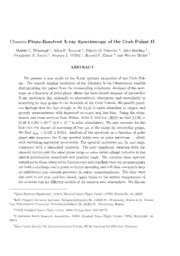
NASA Technical Reports Server (NTRS) 20120008156: Chandra Phase-Resolved X-ray Spectroscopy of the Crab Pulsar II PDF
Preview NASA Technical Reports Server (NTRS) 20120008156: Chandra Phase-Resolved X-ray Spectroscopy of the Crab Pulsar II
Chandra Phase-Resolved X-ray Spectroscopy of the Crab Pulsar II Martin C. \rYeisskopf I, Allyn F. Tennant I, Dmitry G. Yakovlev 2, Alice Harding 3, Vyacheslav E. Zavlin 4, Stephen L. O'Dell 1, Ronald F. Elsner 1, and \rVerner Becker 5 ABSTRACT \rYe present a new study of the X-ray spectral properties of the Crab Pul sar. The superb angular resolution of the Chandra X-ray Observatory enables distinguishing the pulsar from the surrounding nebulosity. Analysis of the spec trum as a function of pulse phase allows the least-biased measure of interstellar X-ray extinction due primarily to photoelectric absorption and secondarily to scattering by dust grains in the direction of the Crab Nebula. We modify previ ous findings that the line-of-sight to the Crab is under-abundant in oxygen and provide measurements with improved accuracy and less bias. Using the abun dances and cross sections from Wilms, Allen & McCray (2000) we find [O/H] = (5.28 ± 0.28) x 10-4 (4.9 X 10-4 is solar abundance). \rVe also measure for the first time the impact of scattering of flux out of the image by interstellar grains. \rYe find Tscat = 0.147 ± 0.043. Analysis of the spectrum as a function of pulse phase also measures the X-ray spectral index even at pulse minimum - albeit with increasing statistical uncertainty. The spectral variations are, by and large, consistent with a sinusoidal variation. The only significant variation from the sinusoid occurs over the same phase range as some rather abrupt behavior in the optical polarization magnitude and position angle. We compare these spectral variations to those observed in Gamma-rays and conclude that our measurements are both a challenge and a guide to future modeling and will thus eventually help us understand pair cascade processes in pulsar magnetospheres. The data were also used to set new. and less biased, upper limits to the surface temperature of the neutron star for different models of the neutron star atmosphere. We discuss Sciences N ASA ~larshall VP62, AL 35812 Russia St. Peters- ~m 20771 AL 35812 Planck 85740 Miinchen.
